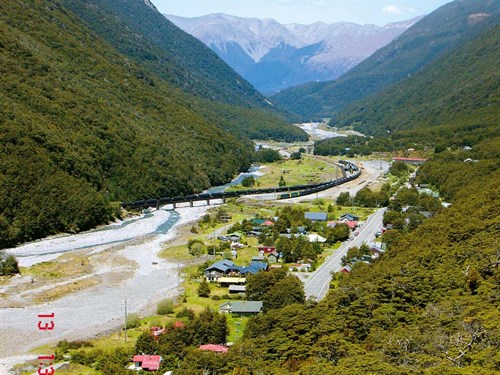
The way south and then west to Arthur’s Pass first crosses the featureless flat of the Canterbury Plains, but an hour away from Christchurch, the road begins the 900-metre climb towards the highest alpine pass in the country.
Even on a day trip it feels like a route to adventure. The village, the pass and the huge national park are named after Arthur Dobson who found the trail over this part of the Southern Alps which had once been used by Maori. When Arthur first described the route, he doubted it was passable for coaches but two years later, 1000 hardy Cantabrians had determinedly scraped a precarious zigzagging route through the mountains in order to bring the gold of the West Coast to their province. Just as doggedly, Coasters decided they preferred the sea route and only one escorted gold trip was ever made.
Today’s travellers on SH73 to the West Coast are treated to the dizzying heights and dramatic landforms of the mountains. It is not a gentle environment. Battering winds often scream through the hills, rain can come down in torrents and snow sometimes brings travelling to a halt.
But when I drove over the pass last spring, the air was cool and still, the mountains benign. Their flanks were streaked with veins of snow and the highest peaks swirled in thin candyfloss cloud. The road passes high country sheep stations, the entranceway to at least four ski areas, a bony hillside of limestone ‘ruined city’ rocks and lacy beech forests. Bill and I turn onto the side road that leads to Broken River and among the beach trees beside a warbling stream, we picnicked on cold sausages and salad, slapping at the sandflies that were also determined to have lunch.
Closer to the pass, beech gives way to alpine grasses and shimmering carpets of foxgloves, violets and daisies. The little straggle of buildings that form the village are five kilometres short of the pass. And it is definitely worthwhile to carry on through the village to the pass itself, marked by Arthur’s rather unremarkable memorial.
Further on is the Otira Viaduct, opened in 1999. The astonishment of the viaduct is not so much driving over it now but as you do so, looking back up to the monumental, 2000-year-old fan of scree spilt down the side of the mountain, and try to locate the scar of the old road creeping across its face. The complex and demanding engineering feat that it took to build the modern viaduct that winds like a piece of modern sculpture around the sides of the valley, is not evident as you sweep down it towards the West Coast.
Jill Malcolm is a former editor of Motorhomes Caravans & Destinations and author of the Great Kiwi Motorhome Guide.





